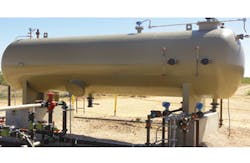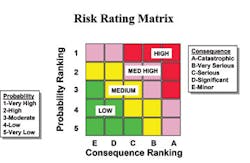Risk-based asset management enhanced through real-time modeling tools
API Risk-Based Inspection (RBI) is a methodology to characterize failure risk through appropriate determination of both the probability and consequence of failure. Consequence-of-failure computation — often represented in terms of economic, safety and environmental effects — has well-set quantifiable criteria. However, the dynamic nature of probability of failure presents a more fundamental and complex task.
Technologies have been developed that facilitate quantification of critical degradation mechanisms such as sour-water corrosion and crude corrosivity through real-time corrosion-prediction models and online monitoring. Process historian and lab-information system data can be correlated to process events in support of real-time risk and integrity analyses.
Such real-time data will in turn be the foundation for an operational framework for asset management supported by appropriate Integrity Operating Windows (IOW) for key process parameters and establishment of an effective boundary-management philosophy driven by accurate, real-time risk analyses.
In an operating plant, a relatively large percentage of risk is associated with a small percentage of equipment items. Risk-based inspection focuses resources on high-risk items first.
RBI evaluates both the probability and consequence of failure. Each is estimated separately, and then are combined to create an associated risk-value or criticality-rating associated with a piece of equipment.
Risk for a given asset appears as a point on an XY plot with probability and consequence axes or as a location on a two-dimensional risk matrix where risk categories are identified as high, medium-high, medium and low, as shown in Figure 1. Risk also can be depicted for operating unit or plant assets as a number in dollars per year, as shown in a cumulative risk curve. The cumulative risk curve is often a key performance indicator for measuring RBI effectiveness.
Probabilities and consequences of failure
Probability of failure (POF) is expressed in a defined scale. Figure 1 presents a POF scale between 1 and 5, where "1" represents a failure likely to occur within one year, and "5" represents an equipment item with additional safety factors or robustness.
A level I corrosion study typically determines potential damage mechanisms for an asset and process. These damage mechanisms include internal and external corrosion, corrosion under insulation (CUI), creep and environmental cracking, as well as thermal or mechanical fatigue.
The consequence analysis aids establishing a relative risk ranking of equipment items. It is a simplified, credible estimate of both safety and financial impacts due to failure, such as might be expected if a containment loss were to actually occur. The business-impact estimate is then converted to a consequence category (A to E), which assigns a relative ranking of consequence-of-failure.
For systems and equipment that may experience a potential loss of process-fluid containment, the equipment contents need to be characterized as a representative fluid. Hazardous fluids generally fall into one of two categories, flammable or toxic, and the main process constituent will generally be the representative fluid. Another consequence category for pressure systems and equipment is "burst/blast," which calculates the over-pressurization effect.
The financial-consequence category should take into account the average-unit-downtime profit loss; shutdown, repair and startup time; and additional equipment replacement or repair costs.
RBI risk assessment is a point-in-time evaluation of the probability and consequence of failure, meaning it calculates the deterioration rate over a given age on a given date. IWPs are therefore generated based on point-in-time risk of a given damage mechanism for a given asset and recommend a maximum interval for performing a specified inspection method.
IOWs and boundary management
The RBI process projects the POF and COF risk profile into the future by assessing risk using current and historic data (e.g. process-data and corrosion measurements) within probabilistic models. However, this does not effectively address short-term, high-impact operating events that may affect risk profile between the point-in-time risk assessment and scheduled inspection. The next evolution in the RBI process should be a framework that incorporates data from real-time corrosion prediction/quantification models, establishes appropriate process IOWs and facilitates more accurate and relevant risk assessments.
Process unit operation requires establishment of operating ranges and limits for key process variables, which allows process unit operators to appropriately control the process. In other words, an IOW is a key operating parameter, such as temperature, that must be constrained to a range to preserve process equipment while optimizing production.
IOWs are a process-operating-limits subset that addresses key-process-parameter controls for process unit safety, productivity, integrity or reliability. Operating limits for key process variables such as pressure, temperature and corrosion are essential because they inherently affect the integrity of the process unit.
When operating condition changes affect key process variables, damage mechanisms may be introduced that significantly affect asset life, process safety and reliability. IOWs identify possible process changes and operating conditions that can affect remaining life, especially when integrated with a risk-based mechanical integrity (RBMI) program that uses real-time corrosion modeling and monitoring.
Figure 2 shows a framework for integrating real-time data sources — including data from corrosion modeling, corrosion monitoring and RBI — into an IOW framework to ensure that process-deviation corrective actions occur before the process becomes critically affected. However, a viable framework must include corrosion quantification through real-time modeling and monitoring.
A Honeywell International-developed framework to support real-time corrosion modeling includes components necessary for real-time RBMI and asset-integrity management.
Real-time modeling and monitoring
In recent years, Honeywell, through a consortium of industry partners, has been involved in developing corrosion-prediction and quantification models for key process applications in the oil-and-gas industry, including models for oil/gas production, pipelines and refining. Refining is the application context used in this discussion.
These models incorporate engineering data and numerical modeling to support rigorous refinery corrosion quantification based on multiphase flow modeling, ionic/thermodynamic/phase behavior modeling and comprehensive laboratory data. Predictive modeling applications include the following:
- Predict-SW: Sour water (NH4HS) corrosion in refinery units, including hydroprocessing, sour water strippers and others.
- Predict-Amine: corrosion in amine Units (MEA, DEA, DGA, MDEA).
- Predict-Crude: High temperature naphthenic acid and sulfidation attack in vacuum distillation units.
- Predict-SAA: Corrosion in sulfuric acid alkylation units.
Traditional corrosion measurement and monitoring methods, including inspection and weight-loss coupons, lack the ability to capture the "present" criticality state of a corroding system. Real-time corrosion models, when combined with real-time monitoring technology, such as Honeywell’s SmartCET, are a compelling way to access corrosion rates as a "process variable."
A complementary aspect of real-time monitoring allows corrosion prediction models working in tandem with the DCS and process historian to provide quantified corrosion rates at multiple process locations. These online, real-time predictions represent "virtual" monitoring points. They enhance the operator’s ability to closely correlate process-upset conditions to detrimental changes in system corrosion behavior.
The framework enables real-time corrosion-rate quantification through configured monitoring points, where corrosion rates sent to the historian are displayed alongside real-time process variations.
Corrosion modeling and monitoring
Recent advances in corrosion monitoring enable correlation of monitored corrosion rates with changes in process variables. These advanced monitoring systems typically combine multiple electrochemical methodologies in one instrument.
Honeywell’s SmartCET technology — combining linear polarization resistance, electro-chemical noise and harmonic distortion analyses techniques — provides real-time measurement of general corrosion rate, pitting occurrence and surface-film formation, with measurement frequencies as rapid as 30 seconds.
RBI, IOWs and boundary management, and real-time modeling and monitoring, all support a real-time risk-based asset management (RBAM) system. Real-time RBAM is a guide toward making and executing highest-value asset decisions during each life-cycle stage by aligning people, processes and technology. Therefore, an effective RBAM system focuses on understanding and managing risks associated with physical assets from the design phase to decommissioning.
Real-time RBAM integrates existing risk-based approaches such as RBI with quantified predictions from real-time models and monitoring systems for optimum process control, generally accepted good engineering practices and proven reliability work practices. An effective RBAM program integrates defined IOWs, operating parameter data from data historians, real-time modeling and monitoring of corrosion rates as defined by process and IOWs, real-time/near-real-time risk assessments from an RBMI application and notification processes to initiate process-deviation corrective actions.
Risk analyses and management is an essential aspect of safe unit operations for process plants. A key challenge for accurate RBI is incorporation of real-time process and corrosion data. A framework has been proposed for defining meaningful integrity operating windows and deviation-management methodologies, as well as performing RBI and probability-of-failure computation through real-time corrosion modeling and monitoring technology incorporation. Its implementation could ensure process safety through imposition of process-unit appropriate limits and operation for enhanced asset integrity and effectiveness.
Sridhar Srinivasan is global business manager – corrosion with Honeywell International.

